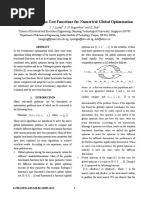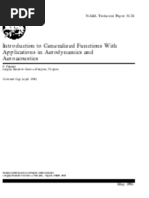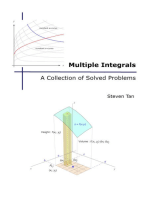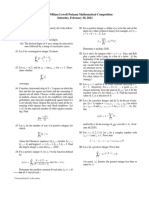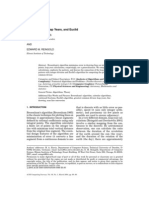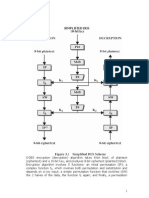Functions
Uploaded by
batooluzmaFunctions
Uploaded by
batooluzmaTest functions for optimization needs
Marcin Molga, Czesaw Smutnicki
3 kwietnia 2005
Streszczenie
This paper provides the review of literature benchmarks (test functions)
commonly used in order to test optimization procedures dedicated for mul-
tidimensional, continuous optimization task. Special attention has been paid
to multiple-extreme functions, treated as the quality test for resistant opti-
mization methods (GA, SA, TS, etc.)
1 Introduction
Quality of optimization procedures (those already known and these newly propo-
sed) are frequently evaluated by using common standard literature benchmarks.
There are several classes of such test functions, all of them are continuous:
(a) unimodal, convex, multidimensional,
(b) multimodal, two-dimensional with a small number of local extremes,
(c) multimodal, two-dimensional with huge number of local extremes
(d) multimodal, multidimensional, with huge number of local extremes, .
Class (a) contains nice functions as well as malicious cases causing poor or slow
convergence to single global extremum. Class (b) is mediate between (a) and (c)-
(d), and is used to test quality of standard optimization procedures in the hostile
environment, namely that having few local extremes with single global one. Clas-
ses (c)-(d) are recommended to test quality of intelligent resistant optimization
methods, as an example GA, SA, TS, etc. These classes are considered as very
hard test problems. Class (c) is articial in some sense, since the behavior of
1
optimization procedure is usually being justied, explain and supported by hu-
man intuitions on 2D surface. Moreover, two-dimensional optimization problems
appear very rarely in practice. Unfortunately, practical discrete optimization pro-
blems provide instances with large number of dimensions, laying undoubtedly in
class (d). For example, the smallest known currently benchmark ft10 for so called
job shop scheduling problemhas dimension 90, the biggest known - has dimension
1980. Therefore, in order to test real quality of proposed algorithms, we need to
consider chiey instances from class (d). As the shocking contrast, the proposed
GA approaches for continuous optimization do not exceed dimension 10.
Notice, polarization (a constant added to function value) has no inuence on
the result of minimization. Therefore, denitions of functions can differ from
these original ones by a constant. All tests are formulated hereinafter as minimi-
zation problems, nevertheless can be applied also for maximization problems by
simple inverting sign of the function.
2 Test functions
In this section we present benchmarks commonly known in the literature.
2.1 De Jongs function
So called rst function of De Jongs is one of the simplest test benchmark. Func-
tion is continuous, convex and unimodal. It has the following general denition
f(x) =
n
i=1
x
2
i
. (1)
Test area is usually restricted to hyphercube 5.12 x
i
5.12, i = 1, . . . , n.
Global minimum f(x) = 0 is obtainable for x
i
= 0, i = 1, . . . , n.
2
-4
-2
0
2
4
x
-4
-2
0
2
4
y
0
10
20
30
40
50
Rysunek 1: De Jongs function in 2D, f(x, y) = x
2
+ y
2
3
-4
-2
0
2
4
x
-4
-2
0
2
4
y
0
20
40
60
80
Rysunek 2: Axis parallel hyper-ellipsoid function in 2D, f(x, y) = x
2
+ 2y
2
2.2 Axis parallel hyper-ellipsoid function
The axis parallel hyper-ellipsoid is similar to function of De Jong. It is also known
as the weighted sphere model. Function is continuous, convex and unimodal. It
has the following general denition
f(x) =
n
i=1
(i x
2
i
). (2)
Test area is usually restricted to hyphercube 5.12 x
i
5.12, i = 1, . . . , n.
Global minimum equal f(x) = 0 is obtainable for x
i
= 0, i = 1, . . . , n.
4
-60
-40
-20
0
20
40
60
x
-60
-40
-20
0
20
40
60
y
0
2000
4000
6000
8000
10000
12000
Rysunek 3: Rotated hyper-ellipsoid function in 2D, f(x, y) = x
2
+ (x
2
+ y
2
)
2.3 Rotated hyper-ellipsoid function
An extension of the axis parallel hyper-ellipsoid is Schwefels function. With
respect to the coordinate axes, this function produces rotated hyper-ellipsoids. It
is continuous, convex and unimodal. Function has the following general denition
f(x) =
n
i=1
i
j=1
x
2
j
. (3)
Test area is usually restricted to hyphercube 65.536 x
i
65.536, i =
1, . . . , n. Its global minimum equal f(x) = 0 is obtainable for x
i
= 0, i =
1, . . . , n.
5
-2
-1
0
1
2
x
-2
-1
0
1
2
y
0
1000
2000
3000
Rysunek 4: Rosenbrocks valley in 2D, f(x, y) = 100(y x
2
)
2
+ (1 x)
2
2.4 Rosenbrocks valley
Rosenbrocks valley is a classic optimization problem, also known as banana
function or the second function of De Jong. The global optimum lays inside a
long, narrow, parabolic shaped at valley. To nd the valley is trivial, however
convergence to the global optimum is difcult and hence this problem has been
frequently used to test the performance of optimization algorithms. Function has
the following denition
f(x) =
n1
i=1
_
100(x
i+1
x
2
i
)
2
+ (1 x
i
)
2
. (4)
Test area is usually restricted to hyphercube 2.048 x
i
2.048, i = 1, . . . , n.
Its global minimum equal f(x) = 0 is obtainable for x
i
, i = 1, . . . , n.
6
-4
-2
0
2
4
x
-4
-2
0
2
4
y
0
10
20
30
40
50
60
70
Rysunek 5: An overview of Rastrigins function in 2D, f(x, y) = 10 2 + [x
2
10 cos(2x)] + [y
2
10 cos(2y)]
2.5 Rastrigins function
Rastrigins function is based on the function of De Jong with the addition of cosine
modulation in order to produce frequent local minima. Thus, the test function is
highly multimodal. However, the location of the minima are regularly distributed.
Function has the following denition
f(x) = 10n +
n
i=1
_
x
2
i
10 cos(2x
i
)
. (5)
Test area is usually restricted to hyphercube 5.12 x
i
5.12, i = 1, . . . , n. Its
global minimum equal f(x) = 0 is obtainable for x
i
= 0, i = 1, . . . , n.
7
-1
-0. 5
0
0.5
1
x
-1
-0. 5
0
0.5
1
y
0
10
20
30
40
Rysunek 6: Zoom on Rastrigins function in 2D, f(x, y) = 10 2 + [x
2
10 cos(2x)] + [y
2
10 cos(2y)]
8
-400
-200
0
200
400
x
-400
-200
0
200
400
y
-800
-600
-400
-200
0
200
400
600
800
Rysunek 7: An overview of Schwefels function in 2D, f(x, y) = x sin(
_
|x|
y sin(
_
|y|
2.6 Schwefels function
Schwefels function is deceptive in that the global minimum is geometrically di-
stant, over the parameter space, from the next best local minima. Therefore, the
search algorithms are potentially prone to convergence in the wrong direction.
Function has the following denition
f(x) =
n
i=1
_
x
i
sin(
_
|x
i
|)
_
. (6)
Test area is usually restricted to hyphercube 500 x
i
500, i = 1, . . . , n.
Its global minimum f(x) = 418.9829n is obtainable for x
i
= 420.9687, i =
1, . . . , n.
9
-100
-50
0
50
100
x
-100
-50
0
50
100
y
-100
-50
0
50
100
Rysunek 8: Zoom on Schwefels function in 2D, f(x, y) = x sin(
_
|x|
y sin(
_
|y|
10
-600
-400
-200
0
200
400
600
x
-600
-400
-200
0
200
400
600
y
0
20
40
60
80
100
120
140
160
180
Rysunek 9: An overview of Griewangks function in 2D, f(x, y) =
x
2
+y
2
4000
cos(x) cos(
y
2
) + 1
2.7 Griewangks function
Griewangks function is similar to the function of Rastrigin. It has many wide-
spread local minima regularly distributed. Function has the following denition
f(x) =
1
4000
n
i=1
x
2
i
n
i=1
cos(
x
i
i
) + 1. (7)
Test area is usually restricted to hyphercube 600 x
i
600, i = 1, . . . , n. Its
global minimum equal f(x) = 0 is obtainable for x
i
= 0, i = 1, . . . , n. The func-
tion interpretation changes with the scale; the general overview suggests convex
function, medium-scale view suggests existence of local extremum, and nally
zoom on the details indicates complex structure of numerous local extremum.
11
-10
-5
0
5
10
x
-10
-5
0
5
10
y
0
0.5
1
1.5
2
Rysunek 10: Medium-scale view of Griewangks function in 2D, f(x, y) =
x
2
+y
2
4000
cos(x) cos(
y
2
) + 1
12
-4
-2
0
2
4
x
-4
-2
0
2
4
y
0
0.5
1
1.5
2
Rysunek 11: Zoom on Griewangks function in 2D, f(x, y) =
x
2
+y
2
4000
cos(x) cos(
y
2
) + 1
13
-1
-0. 5
0
0.5
1
x
-1
-0. 5
0
0.5
1
y
0
0.5
1
1.5
2
Rysunek 12: Sum of different power functions in 2D, f(x, y) = |x|
2
+ |y|
3
2.8 Sum of different power functions
The sum of different powers is a commonly used unimodal test function. It has
the following denition
f(x) =
n
i=1
|x
i
|
i+1
. (8)
Test area is usually restricted to hyphercube 1 x
i
1, i = 1, . . . , n. Its global
minimum equal f(x) = 0 is obtainable for x
i
= 0, i = 1, . . . , n.
14
-30
-20
-10
0
10
20
30
x
-30
-20
-10
0
10
20
30
y
0
5
10
15
20
Rysunek 13: An overview of Ackleys function in 2D, f(x, y) = x sin(
_
|x|
y sin(
_
|y|
2.9 Ackleys function
Ackleys is a widely used multimodal test function. It has the following denition
f(x) = a exp(b
_
1
n
n
i=1
x
2
i
) exp(
1
n
n
i=1
cos(cx
i
)) + a + exp(1) (9)
It is recommended to set a = 20, b = 0.2, c = 2. Test area is usually restricted to
hyphercube 32.768 x
i
32.768, i = 1, . . . , n. Its global minimum f(x) = 0
is obtainable for x
i
= 0, i = 1, . . . , n.
15
-2
-1
0
1
2
x
-2
-1
0
1
2
y
0
2
4
6
Rysunek 14: Zoom on Ackleys function in 2D, f(x, y) = x sin(
_
|x|
y sin(
_
|y|
16
0
2
4
6
8
10
x
0
2
4
6
8
10
y
-4
-2
0
2
4
Rysunek 15: An overview of Langermanns function in 2D. f(x, y) =
m
i=1
c
i
exp((x a
j
)
2
/ (y b
j
)
2
/) cos((x a
j
)
2
+ (y b
j
)
2
), m = 5,
a = [3, 5, 2, 1, 7], b = [5, 2, 1, 4, 9], c = [1, 2, 5, 2, 3]
2.10 Langermanns function
The Langermann function is a multimodal test function. The local minima are
unevenly distributed. Function has the following denition
f(x) =
m
i=1
c
i
exp[
1
j=1
(x
j
a
ij
)
2
] cos[
n
j=1
(x
j
a
ij
)
2
] (10)
where (c
i
, i = 1, . . . , m), (a
ij
, j = 1, . . . , n, i = 1, . . . , m) are constant numbers
xed in advance. It is recommended to set m = 5.
17
0
1
2
3
4
x
-1
0
1
2
3
y
-4
-2
0
2
4
Rysunek 16: Medium-scale view on Langermanns function in 2D. f(x, y) =
m
i=1
c
i
exp((x a
j
)
2
/ (y b
j
)
2
/) cos((x a
j
)
2
+ (y b
j
)
2
), m = 5,
a = [3, 5, 2, 1, 7], b = [5, 2, 1, 4, 9], c = [1, 2, 5, 2, 3]
18
3
3.5
4
4.5
5
x
3
3.5
4
4.5
5
y
-1. 5
-1
-0. 5
0
0.5
1
1.5
Rysunek 17: Zoom on Langermanns function in 2D. f(x, y) =
m
i=1
c
i
exp((x a
j
)
2
/ (y b
j
)
2
/) cos((x a
j
)
2
+ (y b
j
)
2
), m = 5,
a = [3, 5, 2, 1, 7], b = [5, 2, 1, 4, 9], c = [1, 2, 5, 2, 3]
19
2.11 Michalewiczs function
The Michalewicz function is a multimodal test function (owns n! local optima).
The parameter m denes the steepness of the valleys or edges. Larger m leads
to more difcult search. For very large m the function behaves like a needle in
the haystack (the function values for points in the space outside the narrow peaks
give very little information on the location of the global optimum). Function has
the following denition
f(x) =
n
i=1
sin(x
i
)
_
sin(
ix
2
i
)
_
2m
(11)
It is usually set m = 10. Test area is usually restricted to hyphercube 0 x
i
,
i = 1, . . . , n. The global minimum value has been approximated by f(x) =
4.687 for n = 5 and by f(x) = 9.66 for n = 10. Respective optimal solutions
are not given.
20
0
0.5
1
1.5
2
2.5
3
x
0
0.5
1
1.5
2
2.5
3
y
-1. 8
-1. 6
-1. 4
-1. 2
-1
-0. 8
-0. 6
-0. 4
-0. 2
0
Rysunek 18: Michalewiczs function in 2D for m = 1, f(x, y) =
sin(x)(sin(
x
2
)
2m
sin(y)(sin(
y
2
)
2m
21
0
0.5
1
1.5
2
2.5
3
x
0
0.5
1
1.5
2
2.5
3
y
-1. 8
-1. 6
-1. 4
-1. 2
-1
-0. 8
-0. 6
-0. 4
-0. 2
0
Rysunek 19: Michalewiczs function in 2D for m = 10, f(x, y) =
sin(x)(sin(
x
2
)
2m
sin(y)(sin(
y
2
)
2m
22
-4
-2
0
2
4
6
8
10
x
0
2
4
6
8
10
12
14
y
0
50
100
150
200
250
300
Rysunek 20: Braninss function
2.12 Braninss function
The Branin function is a global optimization test function having only two va-
riables. The function has three equal-sized global optima, and has the following
denition
f(x
1
, x
2
) = a(x
2
bx
2
1
+ cx
1
d)
2
+ e(1 f) cos(x
1
) + e. (12)
It is recommended to set the following values of parameters: a = 1, b =
5.1
4
2
,
c =
5
, d = 6, e = 10, f =
1
8
. Three global optima equal f(x
1
, x
2
) = 0.397887
are located as follows: (x
1
, x
2
) = (, 12.275), (, 2.275), (9.42478, 2.475).
23
-20
-10
0
10
20
x
-20
-10
0
10
20
y
-0. 8
-0. 6
-0. 4
-0. 2
0
Rysunek 21: Easoms function
2.13 Easoms function
The Easom function is a unimodal test function, where the global minimum has a
small area relative to the search space. The function was inverted for minimiza-
tion. It has only two variables and the following denition
f(x
1
, x
2
) = cos(x
1
) cos(x
2
) exp((x
1
)
2
(x
2
)
2
) (13)
Test area is usually restricted to square 100 x
1
100, 100 x
2
100. Its
global minimum equal f(x) = 1 is obtainable for (x
1
, x
2
) = (, ).
24
1
2
3
4
5
x
1
2
3
4
5
y
-1
-0. 8
-0. 6
-0. 4
-0. 2
0
Rysunek 22: Zoom on Easoms function
25
-2
-1
0
1
2
x
-2
-1
0
1
2
y
0
200000
400000
600000
800000
1e+06
Rysunek 23: Goldstein-Prices function
2.14 Goldstein-Prices function
The Goldstein-Price function is a global optimization test function. It has only
two variables and the following denition
f(x
1
, x
2
) = [1 + (x
1
+ x
2
+ 1)
2
(19 14x
1
+ 3x
2
1
14x
2
+ 6x
1
x
2
+ 3x
2
2
]
[30 + (2x
1
3x
2
)
2
(18 32x
1
+ 12x
2
1
+ 48x
2
36x
1
x
2
+ 27x
2
2
]. (14)
Test area is usually restricted to the square 2 x
1
2, 2 x
2
2. Its global
minimum equal f(x) = 3 is obtainable for (x
1
, x
2
) = (0, 1).
26
-2
-1
0
1
2
x
-2
-1
0
1
2
y
0
10
20
30
40
50
Rysunek 24: Six-hump camel back function
2.15 Six-hump camel back function
The Six-hump camel back function is a global optimization test function. Wi-
thin the bounded region it owns six local minima, two of them are global ones.
Function has only two variables and the following denition
f(x
1
, x
2
) = (4 2.1x
2
1
+
x
4
1
3
)x
2
1
+ x
1
x
2
+ (4 + 4x
2
2
)x
2
2
. (15)
Test area is usually restricted to the rectangle 3 x
1
3, 2 x
2
2. Two
global minima equal f(x) = 1.0316 are located at (x
1
, x
2
) = (0.0898, 0.7126)
and (0.0898, 0.7126).
27
-2
-1
0
1
2
x
-1
-0. 5
0
0.5
1
y
-1
0
1
2
3
4
5
Rysunek 25: Zoom on six-hump camel back function
28
2.16 Fifth function of De Jong
This is a multimodal test function. The given form of function has only two va-
riables and the following denition
f(x
1
, x
2
) = {0.002 +
25
j=1
[j + (x
1
a
1j
)
6
+ (x
2
a
2j
)
6
]
1
}
1
, (16)
where
(a
ij
) =
_
32 16 0 16 32 32 . . . 0 16 32
32 32 32 32 32 16 . . . 32 32 32
_
The function can also be rewritten as follows
f(x
1
, x
2
) = {0.002+
2
i=2
2
j=2
[5(i +2)+j +3+(x
1
16j)
6
+(x
2
16i)
6
]
1
}
1
,
(17)
Test area is usually restricted to the square 65.536 x
1
65.536, 65.536
x
2
65.536.
29
-40
-20
0
20
40
x
-40
-20
0
20
40
y
0
100
200
300
400
500
Rysunek 26: An overview of fth function of De Jong
30
-20
-10
0
10
20
x
-20
-10
0
10
20
y
0
100
200
300
400
500
Rysunek 27: Medium-scale view on the fth function of De Jong
31
-10
-5
0
5
10
x
-10
-5
0
5
10
y
100
200
300
400
500
Rysunek 28: Zoom on fth function of De Jong
32
-4
-2
0
2
4
x
-4
-2
0
2
4
y
-0. 8
-0. 6
-0. 4
-0. 2
0
Rysunek 29: An overview of drop wave function
2.17 Drop wave function
This is a multimodal test function. The given form of function has only two va-
riables and the following denition
f(x
1
, x
2
) =
1 + cos(12
_
x
2
+ x
2
2
)
1
2
(x
2
1
+ x
2
2
) + 2
(18)
Test area is usually restricted to the square 5.12 x
1
5.12, 5.12 x
2
5.12.
33
-2
-1
0
1
2
x
-2
-1
0
1
2
y
-0. 8
-0. 6
-0. 4
-0. 2
0
Rysunek 30: Medium-scale view on drop wave function
34
-1
-0. 5
0
0.5
1
x
-1
-0. 5
0
0.5
1
y
-0. 8
-0. 6
-0. 4
-0. 2
0
Rysunek 31: Zoom on drop wave function
35
-4
-2
0
2
4
x
-4
-2
0
2
4
y
-150
-100
-50
0
50
100
150
Rysunek 32: An overview of Shuberts function
2.18 Shuberts function
This is a multimodal test function. The given form of function has only two va-
riables and the following denition
f(x
1
, x
2
) =
5
i=1
i cos((i + 1)x
1
+ 1)
5
i=1
i cos((i + 1)x
2
+ 1), (19)
Test area is usually restricted to the square 5.12 x
1
5.12, 5.12 x
2
5.12.
36
-2
-1
0
1
2
x
-2
-1
0
1
2
y
-200
-100
0
100
Rysunek 33: Medium-scale view on Shuberts function
37
-1
-0. 5
0
0.5
1
x
-1
-0. 5
0
0.5
1
y
-200
-100
0
100
Rysunek 34: Zoom on Shuberts function
38
-10
0
10
20
30
x
-10
0
10
20
30
y
-2
-1. 5
-1
-0. 5
0
Rysunek 35: An overview of Shekels foxholes in 2D. f(x, y) =
m
i=1
[(x
a
j
)
2
+ (y b
j
)
2
+ c
j
]
1
2.19 Shekels foxholes
This is a multimodal test function. It has the following denition
f(x) =
m
i=1
(
n
j=1
[(x
j
a
ij
)
2
+ c
j
])
1
, (20)
where (c
i
, i = 1, . . . , m), (a
ij
, j = 1, . . . , n, i = 1, . . . , m) are constant numbers
xed in advance. It is recommended to set m = 30.
39
0
2
4
6
8
10
x
10
12
14
16
18
20
y
-2
-1. 5
-1
-0. 5
Rysunek 36: Zoom on Shekels foxholes in 2D. f(x, y) =
m
i=1
[(x a
j
)
2
+
(y b
j
)
2
+ c
j
]
1
40
2.20 Deceptive functions
A deceptive problem is a class of problems in which the total size of the basins for
local optimum solutions is much larger than the basin size of the global optimum
solution. Clearly, this is a multimodal function. The general form of deceptive
function is given by the following formulae
f(x) =
_
1
n
n
i=1
g
i
(x
i
)
_
, (21)
where is an xed non-linearity factor.
It has been dened in the literature at least three types of deceptive problems,
depending the form of g
i
(x
i
). A complex deceptive problem (Type III), in which
the global optimum is located at x
i
=
i
, where
i
is a unique random number
between 0 and 1 depending on the dimension i. To this aim the following form of
auxiliary functions has been proposed
g
i
(x
i
) =
_
i
+
4
5
if 0 x
i
4
5
i
5x
i
4 if
4
5
i
< x
i
i
5(x
i
)
i
1
+ 1 if
i
< x
i
1+4
i
5
x1
1
i
+
4
5
if
1+4
i
5
< x
i
1
(22)
The two other types of deceptive problems (Types I and II) are special cases
of the complex deceptive problem, with
i
= 1 (Type I), or
i
= 0 or 1 at random
(Type II) for each dimension i, i = 0, . . . , n. Clearly formulae (22) should be
suitable adjusted for type I and II.
For all three types of g
i
(x
i
), the region with local optima is 5
n
1 times larger
than the region with a global optimum in the n-dimensional space. The number
of local optima is 2
n
1 for Type I and Type II deceptive problems and 3
n
1 for
Type III.
41
0
0.2
0.4
0.6
0.8
1
x
0
0.2
0.4
0.6
0.8
1
y
0.6
0.7
0.8
0.9
1
1.1
Rysunek 37: Deceptive function of Type III in 2D.
1
= 0.3,
2
= 0.7, = 0.2
42
0
0.2
0.4
0.6
0.8
1
x
0
0.2
0.4
0.6
0.8
1
y
0
1
2
3
Rysunek 38: Deceptive function of Type III in 2D.
1
= 0.3,
2
= 0.7, = 2.5
43
You might also like
- Buhmann M D - Radial Basis Functions, Theory and Implementations (CUP 2004) (271s)No ratings yetBuhmann M D - Radial Basis Functions, Theory and Implementations (CUP 2004) (271s)271 pages
- Geatbx: Examples of Objective FunctionsNo ratings yetGeatbx: Examples of Objective Functions21 pages
- Definitions of CEC2017 Benchmark Suite Final Version Updated100% (1)Definitions of CEC2017 Benchmark Suite Final Version Updated34 pages
- Definitions of CEC2017 Benchmark Suite Final Version Updated100% (1)Definitions of CEC2017 Benchmark Suite Final Version Updated34 pages
- Definitions of CEC2014 Benchmark Suite Part ANo ratings yetDefinitions of CEC2014 Benchmark Suite Part A32 pages
- Novel Composition Test Functions For Numerical Global OptimizationNo ratings yetNovel Composition Test Functions For Numerical Global Optimization8 pages
- A Literature Survey of Benchmark Functions For Global Optimisation Problems PDFNo ratings yetA Literature Survey of Benchmark Functions For Global Optimisation Problems PDF45 pages
- A Wide Class of Test Functions For Global OptimizationNo ratings yetA Wide Class of Test Functions For Global Optimization5 pages
- Structural and Multidisciplinary OptimizationNo ratings yetStructural and Multidisciplinary Optimization33 pages
- Chapter 4. Extrema and Double Integrals: Section 4.1: Extrema, Second Derivative TestNo ratings yetChapter 4. Extrema and Double Integrals: Section 4.1: Extrema, Second Derivative Test6 pages
- Engineering Analysis: Basics of FunctionsNo ratings yetEngineering Analysis: Basics of Functions63 pages
- Benchmark Functions For The CEC'2010 Special Session and Competition On Large-Scale Global OptimizationNo ratings yetBenchmark Functions For The CEC'2010 Special Session and Competition On Large-Scale Global Optimization23 pages
- Lecture 2- gradient-directional derivativesNo ratings yetLecture 2- gradient-directional derivatives31 pages
- 1.1 Mathematical Model of Production: Tornike KadeishviliNo ratings yet1.1 Mathematical Model of Production: Tornike Kadeishvili13 pages
- MM3&4 - Functions and Transformations Summary NotesNo ratings yetMM3&4 - Functions and Transformations Summary Notes16 pages
- ECOM 6302: Engineering Optimization: Chapter Three100% (1)ECOM 6302: Engineering Optimization: Chapter Three56 pages
- A New Filled Function Method With Two Parameters in A Directional SearchNo ratings yetA New Filled Function Method With Two Parameters in A Directional Search9 pages
- Radial Basis Functions Theory and ImplementationsNo ratings yetRadial Basis Functions Theory and Implementations14 pages
- Mathematical and Computer Modelling: K. Maleknejad, Z. JafaribehbahaniNo ratings yetMathematical and Computer Modelling: K. Maleknejad, Z. Jafaribehbahani12 pages
- Inverse Trigonometric Functions (Trigonometry) Mathematics Question BankFrom EverandInverse Trigonometric Functions (Trigonometry) Mathematics Question BankNo ratings yet
- Introduction to Medical Imaging_ Physics, Engineering and -- Nadine Barrie Smith -- 1, 2010 -- Cambridge University Press -- 9780511913198 -- 7220ed5dcc65a570c46f8661a8c06243 -- Anna’s Archive (1)No ratings yetIntroduction to Medical Imaging_ Physics, Engineering and -- Nadine Barrie Smith -- 1, 2010 -- Cambridge University Press -- 9780511913198 -- 7220ed5dcc65a570c46f8661a8c06243 -- Anna’s Archive (1)71 pages
- An Extension of Golden Section Algorithm For N-Variable Functions With MATLAB CodeNo ratings yetAn Extension of Golden Section Algorithm For N-Variable Functions With MATLAB Code11 pages
- Introduction To Generalized Functions With Applications in Aerodynamics and Aeroacoustics100% (1)Introduction To Generalized Functions With Applications in Aerodynamics and Aeroacoustics53 pages
- Calculus of Variations Solution Manual Russak100% (2)Calculus of Variations Solution Manual Russak240 pages
- Russak (1996) Calculus of Variations Lecture NotesNo ratings yetRussak (1996) Calculus of Variations Lecture Notes133 pages
- Student's Solutions Manual and Supplementary Materials for Econometric Analysis of Cross Section and Panel Data, second editionFrom EverandStudent's Solutions Manual and Supplementary Materials for Econometric Analysis of Cross Section and Panel Data, second editionNo ratings yet
- Hyperbolic Functions (Trigonometry) Mathematics E-Book For Public ExamsFrom EverandHyperbolic Functions (Trigonometry) Mathematics E-Book For Public ExamsNo ratings yet
- A Detailed Survey On Various Image Inpainting TechniquesNo ratings yetA Detailed Survey On Various Image Inpainting Techniques3 pages
- Micro Link Information Technology Business College: Department of Software EngineeringNo ratings yetMicro Link Information Technology Business College: Department of Software Engineering34 pages
- The 81st William Lowell Putnam Mathematical Competition Saturday, February 20, 2021No ratings yetThe 81st William Lowell Putnam Mathematical Competition Saturday, February 20, 20211 page
- Summay Chapter 6 and 8 (Paul Goodwin and George Wright)No ratings yetSummay Chapter 6 and 8 (Paul Goodwin and George Wright)10 pages
- Line Drawing, Leap Years, and Euclid: Mitchell A. HarrisNo ratings yetLine Drawing, Leap Years, and Euclid: Mitchell A. Harris13 pages
- ioGAS Installation and Getting Started 4.5. 64 Bit PDFNo ratings yetioGAS Installation and Getting Started 4.5. 64 Bit PDF8 pages
- E-Letter: Ki51703 Se For Large Scale SystemNo ratings yetE-Letter: Ki51703 Se For Large Scale System14 pages
- Buhmann M D - Radial Basis Functions, Theory and Implementations (CUP 2004) (271s)Buhmann M D - Radial Basis Functions, Theory and Implementations (CUP 2004) (271s)
- Definitions of CEC2017 Benchmark Suite Final Version UpdatedDefinitions of CEC2017 Benchmark Suite Final Version Updated
- Definitions of CEC2017 Benchmark Suite Final Version UpdatedDefinitions of CEC2017 Benchmark Suite Final Version Updated
- Novel Composition Test Functions For Numerical Global OptimizationNovel Composition Test Functions For Numerical Global Optimization
- A Literature Survey of Benchmark Functions For Global Optimisation Problems PDFA Literature Survey of Benchmark Functions For Global Optimisation Problems PDF
- A Wide Class of Test Functions For Global OptimizationA Wide Class of Test Functions For Global Optimization
- Geometric functions in computer aided geometric designFrom EverandGeometric functions in computer aided geometric design
- Chapter 4. Extrema and Double Integrals: Section 4.1: Extrema, Second Derivative TestChapter 4. Extrema and Double Integrals: Section 4.1: Extrema, Second Derivative Test
- Benchmark Functions For The CEC'2010 Special Session and Competition On Large-Scale Global OptimizationBenchmark Functions For The CEC'2010 Special Session and Competition On Large-Scale Global Optimization
- 1.1 Mathematical Model of Production: Tornike Kadeishvili1.1 Mathematical Model of Production: Tornike Kadeishvili
- MM3&4 - Functions and Transformations Summary NotesMM3&4 - Functions and Transformations Summary Notes
- ECOM 6302: Engineering Optimization: Chapter ThreeECOM 6302: Engineering Optimization: Chapter Three
- A New Filled Function Method With Two Parameters in A Directional SearchA New Filled Function Method With Two Parameters in A Directional Search
- Mathematical and Computer Modelling: K. Maleknejad, Z. JafaribehbahaniMathematical and Computer Modelling: K. Maleknejad, Z. Jafaribehbahani
- Inverse Trigonometric Functions (Trigonometry) Mathematics Question BankFrom EverandInverse Trigonometric Functions (Trigonometry) Mathematics Question Bank
- Introduction to Medical Imaging_ Physics, Engineering and -- Nadine Barrie Smith -- 1, 2010 -- Cambridge University Press -- 9780511913198 -- 7220ed5dcc65a570c46f8661a8c06243 -- Anna’s Archive (1)Introduction to Medical Imaging_ Physics, Engineering and -- Nadine Barrie Smith -- 1, 2010 -- Cambridge University Press -- 9780511913198 -- 7220ed5dcc65a570c46f8661a8c06243 -- Anna’s Archive (1)
- An Extension of Golden Section Algorithm For N-Variable Functions With MATLAB CodeAn Extension of Golden Section Algorithm For N-Variable Functions With MATLAB Code
- Introduction To Generalized Functions With Applications in Aerodynamics and AeroacousticsIntroduction To Generalized Functions With Applications in Aerodynamics and Aeroacoustics
- Russak (1996) Calculus of Variations Lecture NotesRussak (1996) Calculus of Variations Lecture Notes
- Student's Solutions Manual and Supplementary Materials for Econometric Analysis of Cross Section and Panel Data, second editionFrom EverandStudent's Solutions Manual and Supplementary Materials for Econometric Analysis of Cross Section and Panel Data, second edition
- Multiple Integrals, A Collection of Solved ProblemsFrom EverandMultiple Integrals, A Collection of Solved Problems
- Hyperbolic Functions (Trigonometry) Mathematics E-Book For Public ExamsFrom EverandHyperbolic Functions (Trigonometry) Mathematics E-Book For Public Exams
- A Detailed Survey On Various Image Inpainting TechniquesA Detailed Survey On Various Image Inpainting Techniques
- Micro Link Information Technology Business College: Department of Software EngineeringMicro Link Information Technology Business College: Department of Software Engineering
- The 81st William Lowell Putnam Mathematical Competition Saturday, February 20, 2021The 81st William Lowell Putnam Mathematical Competition Saturday, February 20, 2021
- Summay Chapter 6 and 8 (Paul Goodwin and George Wright)Summay Chapter 6 and 8 (Paul Goodwin and George Wright)
- Line Drawing, Leap Years, and Euclid: Mitchell A. HarrisLine Drawing, Leap Years, and Euclid: Mitchell A. Harris
- ioGAS Installation and Getting Started 4.5. 64 Bit PDFioGAS Installation and Getting Started 4.5. 64 Bit PDF







